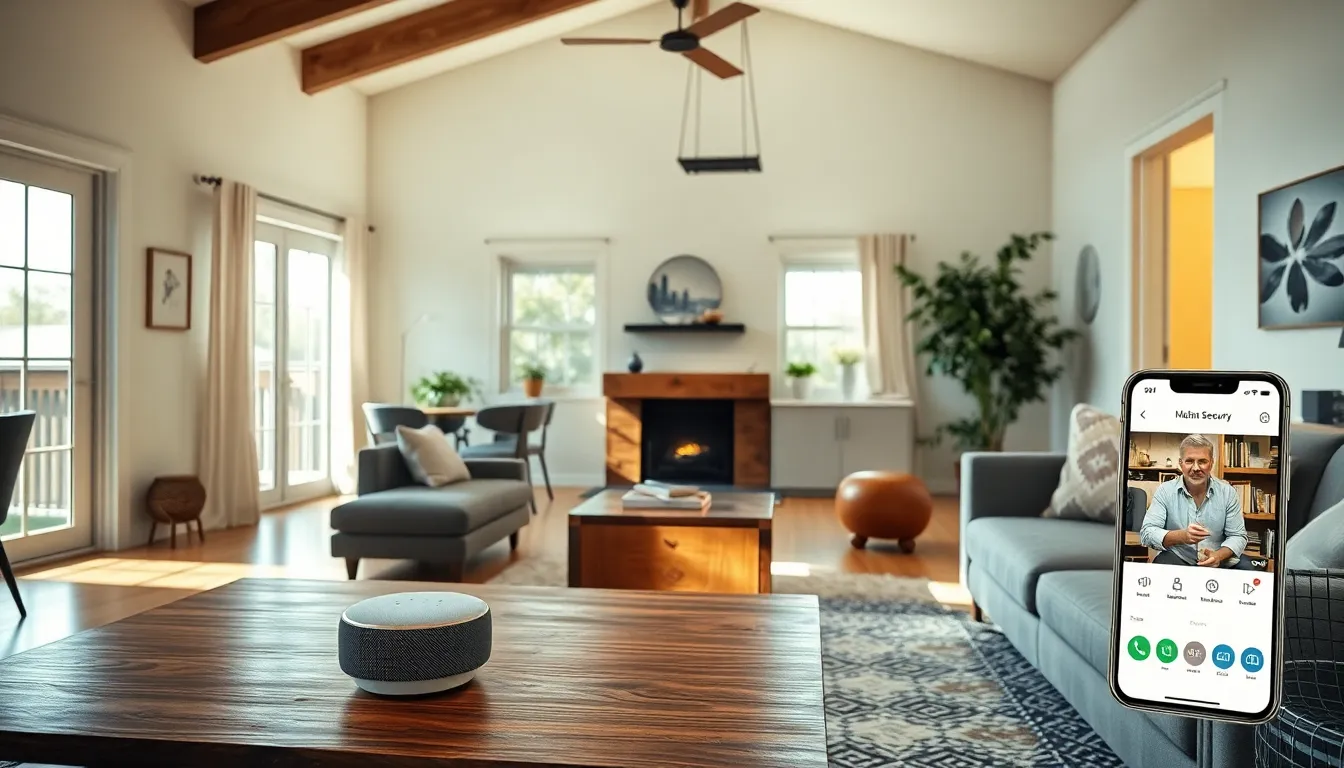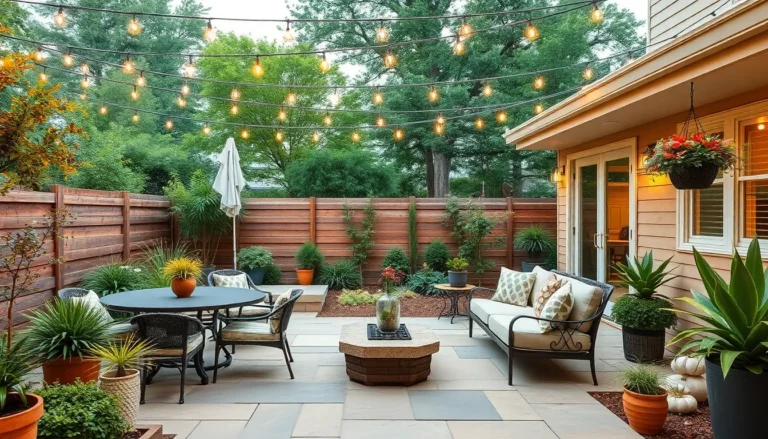Imagine walking into your home after a long day and having the lights turn on, your favorite playlist start playing, and the thermostat adjust to the perfect temperature—all without lifting a finger. Welcome to the world of home automation, where technology transforms your living space into a smart haven. It’s like having a personal assistant who never complains about doing chores.
Home automation isn’t just a luxury; it’s a game-changer for everyday life. With a few smart devices, you can streamline routines, enhance security, and even save on energy bills. Plus, who wouldn’t want to impress their friends with a house that responds to voice commands? It’s time to embrace the future and let technology do the heavy lifting. Get ready to discover how home automation can make life easier, more efficient, and a little more fun.
Table of Contents
ToggleOverview of Home Automation
Home automation refers to the use of technology to control various devices and systems in a residence. This technology allows homeowners to manage lighting, temperature, security systems, and other appliances through centralized platforms. Smart home devices often connect via the internet, enabling remote access and control.
Enhanced convenience is a primary advantage of home automation. For instance, homeowners can schedule their thermostats to adjust temperatures during specific times, ensuring comfort while reducing energy consumption. This capability leads to substantial savings on utility bills.
Improved security is another vital benefit. Automated security systems include cameras, sensors, and alarms that can be monitored remotely. Notifications alert homeowners to any unusual activity, providing peace of mind when away from home.
Integration often characterizes modern home automation. Multiple devices can work together, creating seamless interactions. For example, smart lights can turn on automatically when a security camera detects movement, enhancing safety.
Customization features enable homeowners to tailor settings based on personal preferences. Smart assistants can learn daily routines and adjust schedules accordingly. This adaptability fosters a more personalized living environment.
Market trends indicate a growing interest in home automation technologies. Recent studies show that smart home device installations increased by 25% in the past year. This surge suggests rising consumer demand for convenience, security, and energy efficiency.
Home automation systems can also contribute to sustainability. Smart devices optimize energy use in real time, reducing overall carbon footprints. As tech advancements continue, the potential for smarter, more efficient homes grows.
Benefits of Home Automation

Home automation offers numerous advantages that transform daily living. Increased convenience ranks as one of its primary benefits. Homeowners can control various devices with a simple voice command. Smart technology allows for scheduling so lights can turn on or off automatically. Time savings become evident as tasks that once required manual effort now occur seamlessly.
Enhanced security also stands out among the benefits. Homeowners gain peace of mind through remote monitoring. Alerts for unusual activity keep residents informed. Security systems can integrate with cameras, providing real-time feeds to smartphones. Automated locks allow users to secure their homes even when away.
Energy efficiency represents another significant benefit. Home automation optimizes energy consumption patterns. Programmed thermostats adjust temperatures based on occupancy, leading to reduced utility bills. Smart lighting systems enable automated dimming or shutoff when rooms are unoccupied. Statistics indicate that these features can decrease energy use by up to 30%.
Popular Home Automation Systems
Home automation systems offer various solutions for enhancing the smart home experience. These systems provide convenience, security, and energy efficiency through innovative technology.
Smart Hubs
Smart hubs serve as the central control point for all connected devices. They allow users to manage smart lighting, thermostats, and security systems from a single interface. Popular options include Amazon Echo and Google Nest Hub, which support numerous third-party devices. Seamless integration of smart appliances through these hubs enhances daily routines. Users can create automated schedules, making home management more efficient.
Smart Lighting Solutions
Smart lighting solutions enable homeowners to customize their lighting environments. With options like Philips Hue and LIFX, users can control brightness and colors remotely. Scheduled lighting can mimic occupancy, enhancing security while saving energy. Voice control through smart assistants allows for hands-free operation. These systems significantly reduce energy use with features like automatic shutoff when no one is present.
Security Cameras and Alarms
Security cameras and alarms increase home safety by providing real-time monitoring. Brands like Arlo and Ring offer high-definition video feeds with remote accessibility. Alerts for unusual activity ensure homeowners stay informed about potential threats. Integration with smart hubs enhances control over security features, allowing users to manage systems through a single platform. Automated locking mechanisms further improve home security when residents are away.
Challenges in Home Automation
Home automation presents several challenges that users need to navigate. Compatibility issues often arise due to the vast array of devices available. Different brands and protocols can create barriers, making integration difficult. Homeowners often face challenges when trying to connect devices across ecosystems. Smart devices from various manufacturers might require specific hubs for communication, leading to increased complexity.
Privacy concerns play a significant role in the acceptance of home automation. Users frequently worry about data security as smart devices collect personal information. Many systems continuously monitor user behavior, raising fears of unauthorized access or data breaches. Consumers often seek reassurance that their data remains private and secure. Governments and organizations emphasize the need for stronger regulations to protect user privacy. Enhanced security measures, such as end-to-end encryption, can help address some of these concerns.
Future Trends in Home Automation
Advancements in artificial intelligence are shaping the landscape of home automation. Smart devices are becoming increasingly intuitive, learning user preferences to offer enhanced personalization. Voice recognition technology is playing a vital role, allowing users to execute commands effortlessly through natural language.
Increased interoperability among devices is anticipated, breaking down barriers created by different brands. A standard communication protocol could foster seamless interactions among diverse systems, simplifying user experiences. Moreover, the rise of 5G technology will likely enable faster data transfer, enhancing device responsiveness and reliability.
Sustainability continues to guide innovations in home automation. Energy-efficient systems are expected to feature prominently, with homeowners increasingly seeking solutions that optimize energy consumption. As a result, smart thermostats and lighting systems will play an essential role in reducing carbon footprints.
Market reports indicate a growing focus on security features in home automation systems. Enhanced surveillance technologies will likely offer real-time monitoring and advanced threat detection capabilities. Consumers are becoming more aware of the importance of safeguarding their homes, prompting manufacturers to prioritize security enhancements.
Integration of health monitoring technology could also emerge as a trend. Devices that track indoor air quality, temperature, and humidity will allow users to create healthier living environments. The potential for smart home systems to monitor and respond to health metrics adds an intriguing dimension to home automation.
Finally, augmented reality is expected to influence home automation interfaces. Virtual displays may enhance user interactions, providing a more intuitive way to manage integrated systems. Consumers will benefit from improved accessibility, making home automation technologies more engaging and user-friendly.
Home automation is reshaping how individuals experience their living spaces. By integrating technology into everyday routines, homeowners can enjoy enhanced convenience and security while contributing to energy efficiency. As advancements continue to emerge, the potential for smarter homes is limitless.
Navigating challenges like compatibility and privacy concerns will be essential as the market evolves. Embracing these innovations not only simplifies life but also aligns with a growing commitment to sustainability. The future of home automation promises to be more intuitive and engaging, making it an exciting time for homeowners to explore these transformative technologies.






